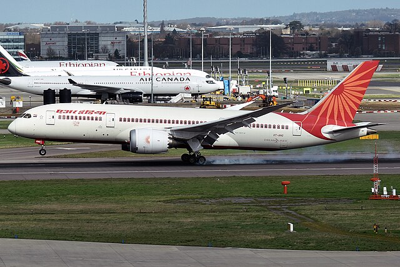On Thursday, June 12, Air India Flight 171, a Boeing 787-8 bound for London Gatwick, crashed just 30 seconds after takeoff from Ahmedabad. The plane reached about 625 feet before plunging into a medical hostel, killing 241 onboard and 39 on the ground, with one passenger surviving.
Both black boxes have been recovered, revealing a Mayday call as the aircraft lost thrust during ascent. The GEnx-powered Dreamliner is under investigation by Indian authorities, with Boeing and GE cooperating. In response, India’s aviation authority ordered fleet-wide 787 inspections, and Air India cut widebody flights by 15% as a precaution.
Preliminary investigations revealed that the Ram Air Turbine (RAT), an emergency power device, activated before impact, indicating severe power loss during the climb. This rare event highlights a crucial point: backup systems are helpful, but early detection of engine issues is essential.
How safe is Chicago’s O’Hare airport?
If a Dreamliner lost power seconds after takeoff at O’Hare, the crew would face a critical choice: abort or attempt an emergency return, while avoiding ground traffic and coordinating with air traffic control and emergency responders.
According to the Bureau of Transportation Statistics and the U.S. Department of Transportation at Chicago, O’Hare (ORD) had 776,000 aircraft movements in 2024, making it one of the world’s busiest and most complex airports. Safety relies on layered systems. Its dense runway and taxiway network require constant precision, especially in poor visibility. While ground emergencies demand coordination, in-flight failures present an entirely different challenge.
While O’Hare is equipped with Engineered Materials Arrestor Systems (EMAS) to safely stop aircraft from overrunning a runway, it does not offer any help during climb-phase emergencies. In-flight incidents place more pressure on pilots, controllers, and rescue services than ground failures.
Past engine failures of the 787 aircraft
Although this is the first fatal crash involving a 787, the aircraft has faced several serious issues, from battery fires to engine failures, across four incidents involving Japan Airlines, Norwegian Air, LATAM, and ANA between 2013 and 2024. These cases show that, despite its advanced design, the Dreamliner is not immune to critical malfunctions.
According to the FAA’s NextGen initiative, to reduce the risk of catastrophic failure during takeoff, aviation must strengthen real-time engine monitoring. Ensuring rigorous crew training for rare dual-engine failures and maintaining seamless coordination between pilots, air traffic control, and emergency teams are critical to managing high-risk situations, especially during takeoff.
How Southwest is improving its runway safety
While no airport is immune to unexpected technical failures, Southwest Airlines—which came to O’Hare in 2021—has outfitted nearly all 800 of its Boeing 737s with a Honeywell-designed cockpit alert system to enhance runway safety.
Following a rise in near misses at US airports, the FAA and Honeywell are taking steps to help prevent runway and taxiway errors. The system issues verbal and text warnings for hazards like incorrect surface use or unsafe landing speeds. Southwest Airlines COO Andrew Watterson called it “a really powerful tool… to add more barriers to potentially bad outcomes.” Alaska Airlines and others are also adopting similar technology to boost runway safety.
Some airlines have not yet installed Honeywell’s runway alert system because retrofitting older aircraft can be costly and complex, and there’s currently no federal requirement to do so. Others are opting to wait for manufacturer-developed systems or focusing on alternative safety strategies, such as enhanced pilot training. Concerns about too many cockpit alerts causing distractions have also slowed adoption in some cases.
With robust systems in place, even rare emergencies can be handled safely. The Air India tragedy is a stark warning and a call to action for every central hub, from Ahmedabad to ORD, to sharpen preparedness and safeguard passengers, ground crew, and communities alike.








(0) comments
Welcome to the discussion.
Log In
Keep it Clean. Please avoid obscene, vulgar, lewd, racist or sexually-oriented language.
PLEASE TURN OFF YOUR CAPS LOCK.
Don't Threaten. Threats of harming another person will not be tolerated.
Be Truthful. Don't knowingly lie about anyone or anything.
Be Nice. No racism, sexism or any sort of -ism that is degrading to another person.
Be Proactive. Use the 'Report' link on each comment to let us know of abusive posts.
Share with Us. We'd love to hear eyewitness accounts, the history behind an article.